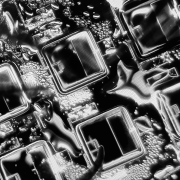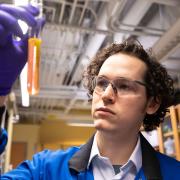Each cell in your body is an incredibly complicated piece of machinery, and we only know the outlines of how they work. If a cell were a car, we’d understand the details for, say, the steering wheel and the transmission, but for large swaths, all we know is “the exhaust comes from this area.”
A new computational study from the University of Chicago adds one piece to this puzzle: how the microtubules—part of the cell’s internal scaffolding—assemble and function. Microtubules are also a frequent target for cancer drugs, so the scientists hope this knowledge can boost the search for better drugs with fewer side effects.
“The behavior of microtubules is one of the basic mysteries of cell biology, so we hope this insight can lead to answers for other questions,” said Gregory Voth, the Haig P. Papazian Distinguished Service Professor of Chemistry at UChicago and one of two authors on the study along with postdoctoral fellow Daniel Beckett.
The final straw
We know that microtubules are a fundamentally important part of the cell. Among other roles, they form the “highways” where collections of molecules get transported around the cell and play a key role when the cell divides.
But questions remained about precisely how microtubules form. They look like straws—a tube that is assembled out of thousands of pairs of proteins that form a lattice. These straws are growing and shrinking and then growing again all the time, as they’re needed in the cell, in a delicate cycle called “dynamic instability”. The shrinking part is important, because if the tubules continue growing unimpeded they would puncture the cell.
But how does it stop?
It’s difficult to tell using microscopes: the type of microscope needed to see things this small can only take snapshots rather than movies, and this reaction happens too fast to easily capture.
Instead, Beckett and Voth turned to computer simulation. They painstakingly built and ran simulations of the processes underlying microtubule shrinkage, using quantum mechanics-based methods to describe the key chemistry.
This model was so complex that it took two years of computing time to run. But it resolved a mystery.
As the proteins assemble into the lattice, the proteins lower down start to get squished together. This compaction brings certain amino acids closer together and accelerates a critical reaction called GTP hydrolysis, which leads to instability and stops the assembly process. The tubule begins to fall apart.
“It was thought maybe the compaction was an aftereffect, but it looks like the compaction is actually a necessary factor for hydrolysis to occur,” said Beckett.
A target for cancer drugs
Because microtubules are so important for cells to divide, they are the target of a number of cancer drugs. Cancer cells grow out of control, so anything that makes them unable to divide is extremely useful. But these drugs may often have harsh side effects, because microtubules do lots of other things in the cell—so a drug that affects them also affects other important cell processes.
However, a better understanding of this process could allow researchers to try to design drugs that more precisely target cancerous activity while leaving other functions less affected.
“For example, perhaps you could design a way to ‘pause’ microtubule growth rather than destroy them,” said Beckett, who has since joined the biotechnology company Jnana Therapeutics.
There are other potential uses too, Voth said, such as biomimetic materials. It could also help us understand why and how cells evolved the way they did.
“This study has provided unprecedented detail of one of the most fundamentally important processes in nature,” he said.
Computational resources were provided by the U.S. Department of Defense and the UChicago Research Computing Center.
Citation: “Unveiling the catalytic mechanism of GTP hydrolysis in microtubules.” Beckett and Voth, Proceedings of the National Academy of Sciences, June 26, 2023.
Funding: National Institutes of Health, U.S. Department of Energy’s Office of Basic Energy Sciences.

